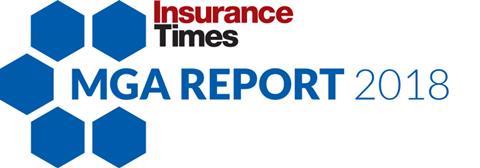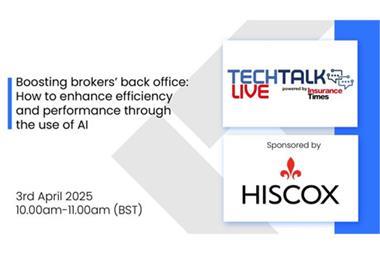GIROUX is a London-based, insurance-focused data warehouse and analytics company, offering secure, enterprise-grade tools with intuitive self-service insight discovery and mobile capabilities. The two directors of the company, Eric Giroux and Kevin Allchorne, spoke to Insurance Times about the challenges and opportunities facing the MGA Analytics market today.

Part of the growth in MGAs has been fuelled by the specialist underwriting service they offer. How does Giroux help MGAs find greater insights into underwriting performance?
Even the smallest, simplest MGAs can find themselves inundated with data from many different partners and distribution channels and in multiple formats. Without the right tools, it is a huge challenge to take all this data and turn out even the most rudimentary underwriting reports. As they grow in size and complexity, this challenge grows exponentially.
Too often it involves valuable employees spending most of their working hours buried deep in a spreadsheet hell. Not only is this slow, cumbersome, prone to error and demotivating, it is also a potential compliance nightmare when it comes to data security and GDPR.
Above all though, it just doesn’t give the business the insight it needs. Rudimentary underwriting reports are simply not enough when you’re faced with a highly competitive market and an Insurtech onslaught, combined with ever more demanding capacity providers.
Giroux’s proven method of agile data warehouse design and deployment combined with world-class technology means we can easily combine these multiple data sources – however many, however large and however complex. Our clients can rapidly combine and analyse metrics such as premium, claims, exposure and quote data over many different dimensions or attributes such as by broker, by product, by geography, or by age, limited only by the data they capture.
Dashboards and reports are completely customisable, depending on the user’s preference, and all data visualisation tools are available at the click of a mouse. MGAs and their capacity providers will quickly find answers to their questions about what’s driving and detracting from underwriting performance and be able to drill down to the most granular level. They will even find answers to questions they hadn’t originally thought of asking!
An MGA you recently worked with had an issue returning a book of business to a profitable status, how did Giroux analyse the book and what insights did you find?
Giroux doesn’t analyse the book, it organises the data surrounding it for powerful analysis. Giroux gives the MGA the tools to take control of their data whilst applying a robust analytical framework to answer existing and emerging questions.
A good example would be where the Giroux platform provided a heat map of loss ratios by region. Instantly, the MGA could see where the loss ratio was running a little hot relative to the rest of the portfolio. It took a few clicks of the mouse to find out which product was involved, whether it was a specific postcode or broker and whether it was due to a few large claims or a frequency issue. It’s important to understand, however, that the combinations of metrics and methods of visualisations are endless, limited only by the data that has been captured.
Attracting greater capacity is a key concern of brokers using an MGA. How have you worked with MGAs to improve trust and knowledge-sharing with their capacity providers?
Capacity providers are facing tough market conditions and poor results in many lines. Combine this with aggressive FCA regulation and more stringent data protection, and it’s easy to see why there is a flight to quality when it comes to delegating underwriting authority to MGAs. Giroux’s platform gives its MGA clients a decisive competitive advantage in their capacity provider relationships. As we mentioned earlier, they are able to demonstrate and communicate a deep understanding of the drivers of underwriting performance and effortlessly meet all the necessary reporting requirements.
Underwriting and compliance reports, claims and premiums triangles, bordereaux – among others – can all be customised specifically according to the capacity provider’s preferences. They can even provide secure and ring-fenced access to the capacity provider which will show only the data and reports relevant to them. Clearly this level of professionalism and transparency will go a long way towards building their trust and respect as a partner and will be key to securing and growing capacity.
The increase in data analytics provides insurers and MGAs with interesting predictors of risk without asking customers questions. What advantages and disadvantages can this bring to a consumer seeking to buy insurance?
There are clearly many potential advantages to the consumer. Perhaps they can be summed up as affordability, choice and convenience.
The ability to analyse insurance data augmented with external ‘big data’ at a granular level means that consumers will increasingly be offered products that are more tailored to them as an individual, and more specific to their needs. Potentially this could improve affordability by enabling them to unbundle insurance products and choose exactly what and when they want to insure. Clearly automation, the use of technology in distribution and perhaps increased competition from companies outside the traditional insurance space could all drive cost and margin out of the business, increasing affordability yet more.
It should also greatly improve consumer experience when interacting with the insurer, whether it be the quoting and buying process or making a claim. Consumers are becoming so used to apps giving instant solutions to so many of life’s tasks, and insurance will be no exception. The use of data algorithms is already beginning to reduce the need for filling out long, complicated proposal or claims forms.
On the downside, there is a price to pay for this affordability, choice and convenience. Our personal data is out there and seemingly available to anyone who wants to pay for it, or more menacingly, hack into it! GDPR seeks to give some of the control back to consumers, but of course presents a huge logistical challenge for insurers – unless, of course, they use a Giroux platform. It is also conceivable that some consumers will find themselves on the wrong side of quoting or claims handling algorithms, where in the past they would have had more recourse to human intervention.
Data has always been at the heart of the insurance industry. How do you foresee AI and machine learning evolving in the industry?
AI and machine learning are already being used to refine customer segmentation and risk pricing as well as to expedite various processes. One would expect an inverse relationship between the sophistication of the AI and the proportion of business requiring human intervention, for example an underwriter or claims handler. Thus far this has been largely confined to the homogeneous, high-volume, low-value lines of business such as personal auto, renters or contents. However, as AI capability develops, it seems inevitable that it will start to move up the scale in terms of complexity of insurance products.
It remains to be seen when, where or whether this evolution reaches a limit. Many Lloyd’s underwriters will say that underwriting is a combination of art and science but some will argue that the ‘art’ part is simply knowledge and experience that has yet to be delineated in an underwriting model.
In more complex risk areas, we would envisage the evolution of ‘bionic underwriters’, where the underwriter’s knowledge and experience is augmented by AI.
This is all currently in the domain of the so called Insurtech, but more traditional MGAs should be thinking about these changes and the threats and opportunities they pose. At Giroux, we see ourselves as facilitators for traditional insurance businesses to turn themselves into Insurtech businesses by helping to deliver a unified data platform for decisions and AI.
Giroux guides insurers through a journey of three basic steps:
1) It begins with taking control of your own data;
2) This is augmented with external, or ‘big’ data;
3) AI and machine learning can be used to look for patterns to aid risk pricing, customer segmentation, product development and focused marketing, among others.
What new tech innovations have you got a close eye on that you haven’t quite adopted just yet at Giroux?
One of the key developments we are interested in is distributed ledger technologies. The world of transactional data will change vastly over the coming decade. Distributed ledger technology, commonly called blockchain technology, will be increasingly used simply because it has data integrity. This is something we are watching closely to understand how we can use it to empower people to make better decisions. Blockchain technologies will increase the velocity and volume of data and MGAs will still need a way to harness that increase in data flows and this is where we come into play.
In the next few years we will need to understand how to marry the block chain movement with centralised, AI assisted, decision-making. Bridging AI and distributed ledgers is where we see a lot of great opportunities.
With GDPR on its way, what solutions do you offer that can help business be in line with GDPR compliance?
We help achieve GDPR compliance in three ways. One is the question around where data is. It’s one of the key questions any provider has to face. They need to understand where their data is, and how it is managed around various risks, and also around the requests that they may get from a consumer. We’ve been in the business for ten years, and this is one of the first things we help companies get a grip of.
The second thing we can help with is the notion of self-service. A lot of GDPR regulation is about receiving requests, and it can be quite daunting for companies to cope with that. We have this feature by default. If you can’t provide a consumer individualised access, with an ability to self-serve around requests, they you have to consume precious resources.
The third area is the rapid audit Giroux has in place. We have a seven-day rapid audit around the data. In one week we can lay out a maturity framework, which we developed in collaboration with Microsoft. This shows you where you are on GDPR in an objective fashion, and we can help you put a plan in place to evolve and meet compliance.
Do you think GDPR has the capacity to create chaos through the insurance industry supply chain on the scale of the PPI scandal?
The ICO has said that they will be looking for scalps. The government has clearly sent a message that they mean business when it comes to data privacy and GDPR. We don’t think that chaos will suddenly happen; it will probably be something between the PPI scandal and Y2K. The world won’t stop. We have a lot of enquiries asking for us to help, so we feel that there is a real commitment to comply with GDPR.
They probably won’t be targeting our typical MGA customer directly, but they will target some of the carriers that are providing capacity to the MGAs. The size of the fine that can potentially be imposed on transgressors, and the damage this brings to reputation, will only amplify the flight to quality. The large capacity providers will only want to deal with MGAs who they can trust as sound stewards of private data.














































No comments yet